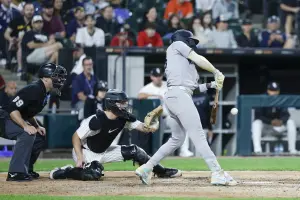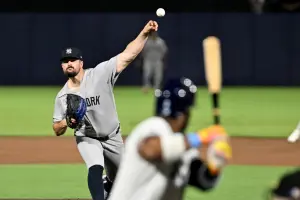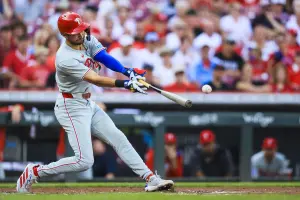
(*) F/F SPOTLIGHT: Avisail Garcia
[Ed. note—We kick off our second week of incorporating 2017 stats into all our Fact/Fluke pieces with the return of Fact/Fluke SPOTLIGHT, where we take a deep dive into one specific player. This is our fourth season of this column, which expands our classic Fact/Fluke model to include additional evaluation tools such as heat maps, spray charts, pitch selection data, and more. Fact/Fluke SPOTLIGHT will run every Wednesday through mid-August.]
Some young bats pass the eye test better than others. Take Avisaíl García (DH/RF, CHW) for example. At 6’4”, 240 lb, he looks like someone who should produce big numbers. He’s big and athletic, and he shows mammoth power during batting practice.
After years of underperforming his tools, the market has soured on him. His 408 ADP this season was a reflection of years of disappointment. Owners drafted him as their 4th or 5th outfielder instead of as a growth stock with breakout potential. And they took that approach with him even during his age-26 season.
That level of pessimism might explain why Garcia is not getting a lot of attention for his quick start this season. Interestingly, his OPS in April was one of the top-10 best among OF in MLB:
-
OPS by Outfielders—April 2017 Name OPS ================ ===== Harper, Bryce 1.281 Judge, Aaron 1.161 Trout, Mike 1.151 Kemp, Matt 1.077 Conforto, Michael 1.055 Haniger, Mitch 1.042 Davis, Khris 1.032 Garcia, Avisail 1.029 Cespedes, Yoenis .992
He certainly has some good company on that list. Given his age and raw tools, is this the precursor to a breakout or another isolated flash that he will have trouble sustaining? Let's put him under the spotlight.
There’s more where this came from to help you win your fantasy league in 2017. Take the title home with a subscription to BaseballHQ.com.
- Background
Garcia was signed out of Venezuela by the Tigers and made his professional debut in the DET system at age 17.
He was called a five-tool prospect in some circles, evoking comparisons by management in the DET system to both Miguel Cabrera and Vladimir Guerrero.
“Guerrero was a five-tool talent when he was young, and so is Avisail. I don’t think it’ll be long before you see him in the majors if he keeps making strides.” – Joe DePastino, Low-A West Michigan Manager, August 2010
- Minor League History
Year Age Level AB BA HR RBI OPS SB Eye ==== === ======== === ==== == === ==== == ==== 2008 17 Rookie 245 .298 7 34 .791 7 0.38 2009 18 High-A 299 .264 1 31 .613 8 0.11 2009 18 Low-A 8 .250 0 0 .500 0 0.00 2010 19 Low-A 494 .281 4 63 .669 20 0.18 2011 20 High-A 488 .264 11 56 .686 14 0.14 2012 21 High-A 266 .289 8 36 .771 14 0.19 2012 21 Double-A 215 .312 6 22 .810 9 0.18 2013 22 Triple-A 147 .374 5 23 .947 4 0.25
As has often been the case in the DET farm system, players have been promoted more on tools rather than results or skills. Garcia was no different. In spite of showing huge holes in his game at multiple stops in the minors, he moved up the ladder at a swift pace. As a result, there was no incentive for him to learn how to make contact or figure out how to tap into his raw power. The Tigers were enamored with his tools more than his results.
They called him up from Double-A in 2012 after his best professional stint in the minors up to that point. He even jumped into Baseball America’s top 100 prospects after that season. Predictably, his bat wasn’t MLB-ready with the Tigers (0 HR, 3/10 BB/K in 47 AB).
Garcia was better in Triple-A in 2013 but did not hit in his second stint with DET either. He was traded from DET to CHW in a three-team deal involving Jake Peavy and José Iglesias.
- MLB Stats and Skills: 2012 to 2016
Garcia has never been able to put his tools to consistent use at the MLB level.
His production has been marginal at best:
Year OPS ==== ==== 2012 .692 2013 .731 2014 .718 2015 .675 2016 .692
His ability to make contact stagnated for years before bottoming out last season:
Year ct% ==== === 2012 79% 2013 76% 2014 74% 2015 75% 2016 72%
In spite of his physical frame, there has been only one season that he has shown above-average power:
Year PX ==== === 2012 0 2013 91 2014 124 2015 73 2016 92
The reason has been a high groundball stroke that he has never been able to shake:
Year GB% ==== === 2012 62% 2013 56% 2014 56% 2015 49% 2016 55%
And the 20-SB season he put up in the minors never has materialized in MLB, as he has added muscle to his frame. Accordingly, Garcia’s speed skills have been below-average for the last three years:
Year Spd ==== === 2012 101 2013 143 2014 73 2015 94 2016 90
Hot Zones
Garcia hasn’t produced a .280+ BA since 2013. A look at his hot zones explains why. While he’s a .400 hitter at pitches in the middle of the strike zone, pitchers can attack him with great success high and out of the strike zone (all hot zone graphics courtesy of BrooksBaseball.net):
His hot zones for batting average are similar against LH and RH pitchers. Both know that the book on him is to elevate pitches:
Contact
We know that Garcia has a long history of striking out a lot and walking very little. That high level of strikeouts has contributed to his historically low BA.
His poor batting eye is evident in his O-Swing%, which is the percentage of swings he makes at pitches thrown outside of the strike zone (plate discipline metrics courtesy of FanGraphs.com).
Garcia chases pitches outside of the zone much more than league average:
Year O-Swing% MLB Avg ==== ======== ======= 2012 47% 30% 2013 42% 30% 2014 41% 31% 2015 45% 31% 2016 40% 30%
Early in his MLB career, Garcia was able to make decent or better contact on pitches outside of the strike zone (O-Contact%). But that skill has evaded him in recent years, which has made him even more prone to poor strike zone judgment:
Year O-Contact% MLB Avg ==== ========== ======= 2012 71% 67% 2013 66% 67% 2014 52% 66% 2015 55% 65% 2016 50% 64%
Finally, his batting average woes can be reflected in the overall swing-and-miss in his profile; it’s not just a pitch recognition issue. Garcia’s swinging strike rate has been almost double the MLB average over the last several seasons:
Year SwK% MLB Avg ==== ==== ======= 2012 12% 9% 2013 16% 9% 2014 18% 10% 2015 17% 10% 2016 17% 10%
In case you’re wondering if Garcia’s approach at the plate shows a significant LH/RH split, note that his ct% vL and vR has been +/- 2% in each of the last three seasons. He doesn't make good contact against anyone.
In summary, Garcia swings at a lot of pitches outside the zone, does not make much contact against those pitches, and produces a lot of whiffs. Those significant holes explain why he has been a .240-.250 hitter for most of his career.
Power
Garcia’s power output hot zones are similar to his batting average hot zone in that nearly all of his power comes against pitches in the middle of the strike zone. The exception is that he’s able to show some power when he’s able to stretch out his arms and make contact against pitches that are on the outer-portion of the plate:
While the holes in Garcia’s swing and his poor batting eye is apparent against both lefties and righties, Garcia does show a big LH/RH production split.
He has posted a .700+ OPS against righties in just one of his five MLB seasons leading up to 2017. His power skills against them have been routinely subpar:
Year PX vR ==== ===== 2013 81 2014 100 2015 71 2016 88
His lefty/righty power splits are also evident in his ISO hot zones. His power skills start to explode in the middle and outer parts of the strike zone against lefties:
Garcia’s power hot zones become much cooler against same-sided pitchers:
In addition, a look at Garcia’s exit velocity by type of pitch confirms that he hits the ball with more authority against soft stuff than hard stuff, another example of why pitchers have had good success with elevating pitches against him (exit velocity courtesy of BrooksBaseball.net):
- 2017 Results
Power
With all of the above reasons for pessimism heading into 2017, there were not many reasons to speculate on a breakout from Garcia this season; his age was the only real one. That said, Garcia owns a near triple-digit OPS after the first five weeks of the season (5 HR, .979 OPS in 105 AB), finally showing the raw power tools that match his physique (.210 ISO in 2017 vs. .140 ISO in 2016).
Since you likely own him for power, let’s find out if he’s on his way to a 20+ HR breakout or not.
We know that his groundball stroke has been one primary factor that has inhibited his power output. Turns out that hasn't changed much:
Year GB% ==== === 2012 62% 2013 56% 2014 56% 2015 49% 2016 55% 2017 51%
Garcia is still hitting groundballs in over half the balls he is putting into play. The reason for his HR spike in the early-going has been a 22% HR/F, the highest mark of his career.
His average exit velocity of 88.7 mph is 83rd-best in MLB. It’s actually 1.5 mph lower than the exit velocity he posted in 2016.
Another way to measure HR power is to look at the launch angle a batter generates, as consistent HR-hitters have both good exit velocity and high launch angles.
In 2016, Garcia’s launch angle was a paltry 5.3 degrees, which ranked 414 out of 464 qualified batters (launch angle graphics courtesy of MLB Statcast data).

In 2017, Garcia has nearly doubled his launch angle to 9.1 degrees. However, that mark ranks him #157 out of 225 qualified batters.

So, Garcia isn’t hitting the ball as hard as he did last season, but he’s been able to launch balls into the air at a higher angle.
Batting Average
Owners of Garcia have been treated to a .362 BA after his first 105 AB.
Problem is, there is one indicator that has driven up his BA more than any other one:
Year h% ==== === 2013 35% 2014 29% 2015 32% 2016 31% 2017 43%
Over one-third more balls that Garcia puts into play are landing as hits compared to his prior norm. It’s not a rate that will stick given his reduced exit velocity and stagnant rate of hard contact (101 HctX in 2016, 101 HctX in 2017).
Furthermore, a look at Garcia’s plate skills reveals that he hasn’t changed his approach at the plate very much so far in 2017:
Year bb% ct% Eye ==== === === ==== 2013 4% 76% 0.15 2014 8% 74% 0.32 2015 6% 75% 0.26 2016 8% 72% 0.30 2017 5% 77% 0.25
Garcia is striking out a little bit less than his prior norms, but those gains have been offset by a reduction in walks, keeping his batting eye very poor.
Finally, Garcia’s prior weaknesses at the plate that have driven his poor batting eye have not gotten much better.
He continues to swing and pitches outside of the zone at a rate well above the MLB average:
Year O-Swing% MLB Avg ==== ======== ======= 2012 47% 30% 2013 42% 30% 2014 41% 31% 2015 45% 31% 2016 40% 30% 2017 39% 29%
He's also still struggling to make contact on those pitches:
Year O-Contact% MLB Avg ==== ========== ======= 2012 71% 67% 2013 66% 67% 2014 52% 66% 2015 55% 65% 2016 50% 64% 2017 53% 63%
And he continues to carry a lot of swing-and-miss in his profile:
Year SwK% MLB Avg ==== ==== ======= 2012 12% 9% 2013 16% 9% 2014 18% 10% 2015 17% 10% 2016 17% 10% 2017 16% 10%
- Conclusions
There are strong reasons to believe that Garcia’s hot start is not likely to continue. Those searching for optimism might say that if he can continue to increase his launch angle, there remains hope that he could turn himself into a 20-25 HR threat. But even with the improvements he has made there so far in 2017, his expected power rate remains chronically mediocre:
Year xPX ==== === 2013 92 2014 89 2015 90 2016 77 2017 96
With a groundball stroke and launch angle that remains among the bottom of qualified batters, even 20 HR might be an optimistic power ceiling at the moment for Garcia.
Garcia also has not made progress with his plate control skills. He continues to chase pitches and make very little contact against them.
At age 26, Garcia still carries untapped upside, especially given his impressive physical skills. But his hot start this season is much more likely to be a mirage than a building block.








